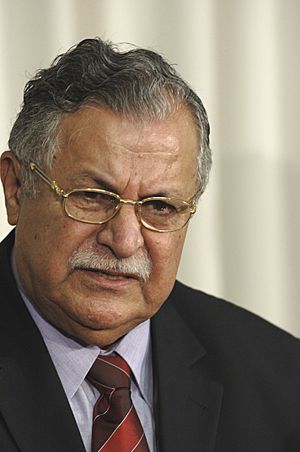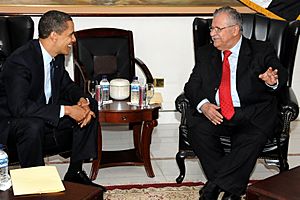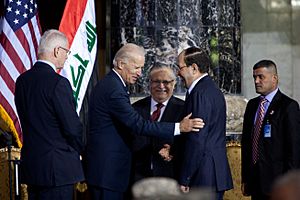Jalal Talabani facts for kids
Quick facts for kids
Jalal Talabani
|
|
|---|---|
|
جەلال تاڵەبانی
|
|

Talabani in 2005
|
|
| 6th President of Iraq | |
| In office 7 April 2005 – 24 July 2014 |
|
| Prime Minister |
|
| Vice President |
|
| Preceded by | Saddam Hussein |
| Succeeded by | Fuad Masum |
| President of the Governing Council of Iraq | |
| In office 1 November 2003 – 30 November 2003 |
|
| Preceded by | Ayad Allawi |
| Succeeded by | Abdul Aziz al-Hakim |
| Leader of the Patriotic Union of Kurdistan | |
| In office 1 April 1975 – 3 October 2017 |
|
| Preceded by | Position established |
| Succeeded by | Kosrat Rasul Ali |
| Personal details | |
| Born |
Jalal Husamuddin Talabani
1933 Kelkan, Kingdom of Iraq |
| Died | 3 October 2017 (aged 83–84) Berlin, Germany |
| Resting place | Dabashan, Sulaymaniyah |
| Political party |
|
| Spouse |
Hero Ibrahim Ahmed
(m. 1970) |
| Children |
|
| Alma mater | University of Baghdad |
Jalal Talabani (Kurdish: مام جەلال تاڵەبانی, romanized: Celal Talebanî; Arabic: جلال طالباني Jalāl Ṭālabānī; 1933 – 3 October 2017) was an important Iraqi politician. He was the sixth president of Iraq from 2005 to 2014. He was also the first president of Iraq who was not Arab. He helped lead the country after a big change.
Mr. Talabani started a major Kurdish political group called the Patriotic Union of Kurdistan (PUK). He worked for over 50 years to get more rights for Kurdish people. He also helped bring democracy to Iraq. He was a key person in the government that took over after Saddam Hussein.
Contents
Early Life and Education
Jalal Talabani was born in a village called Kelkan in 1933. His family was well-known. He went to school in places like Koya (Koysanjak) and Kirkuk.
When he was a teenager, his friends started calling him "Mam" Jalal. In the Kurdish language, 'mam' means "paternal uncle." This was a loving nickname, and people called him that ever since.
In 1953, he started studying law at Baghdad University. He had to leave Iraq for a short time in 1956. This was to avoid being arrested for his student activities. He lived in Syria and helped start the Kurdistan Democratic Party of Syria. He later returned to Iraq and finished his law degree in 1959.
Political Career and Kurdish Rights
After university, Talabani joined the Iraqi Army. He served as a tank unit commander for a short time. In the early 1960s, he became a leader in the Kurdistan Democratic Party (KDP).
Fighting for Kurdish Rights
In September 1961, the Kurdish people in northern Iraq started an uprising. They wanted more rights from the government in Baghdad. Talabani led fighters in different areas. He organized and led movements for Kurdish self-rule.
In March 1962, he led an attack that freed the Sharbazher district. During the 1960s, Talabani also traveled a lot. He represented Kurdish leaders in meetings across Europe and the Middle East.
In 1964, he had disagreements with the Barzani family, who also led the KDP. Talabani left Iraq and went to Iran. He bought weapons there without the Barzanis knowing. Because of this, he was removed from the KDP in 1964.
Forming the PUK
In 1970, the Iraqi government and Kurdish rebels made an agreement. Talabani returned to Iraqi Kurdistan and rejoined the KDP. However, the Kurdish movement faced a setback in 1975. Iran stopped supporting them after making a border deal with Iraq. This deal was called the 1975 Algiers Agreement.
Talabani believed it was time for a new direction. In 1975, he and other Kurdish thinkers started a new group. They founded the Patriotic Union of Kurdistan (PUK).
In 1976, he began to organize an armed campaign for Kurdish independence. He set up PUK bases in both Iranian and Iraqi Kurdistan. During the 1980s, Talabani worked with Iran. He led a Kurdish struggle from inside Iraq.
After Iraq invaded Kuwait in 1990, Talabani went to the United States. He offered his help and troops to the U.S. He wanted to gain support for the PUK.
Working for Peace
In 1991, he helped start a new push for Kurdish independence. He talked with the Iraqi government to arrange a ceasefire. This helped save many Kurdish lives. He also worked closely with the United States, United Kingdom, and France. They helped set up a safe area in Iraqi Kurdistan.
In 1992, the Kurdistan Regional Government was formed. Talabani also supported peace talks between the Kurdistan Workers' Party and Turkey. He was there when a ceasefire was announced in 1993.
Talabani worked for a peaceful solution to the Iraqi Kurdish Civil War. He also worked on the bigger issue of Kurdish rights in the region. He cooperated with other Kurdish politicians. He also worked with other Iraqi opposition groups.
Talabani and other Kurdish leaders played a key role. They partnered with the U.S.-led forces in the 2003 invasion of Iraq. Talabani was a member of the Iraqi Governing Council. This council helped create Iraq's temporary constitution. This constitution guided all politics in Iraq.
Presidency of Iraq


Jalal Talabani was elected President of Iraq on April 6, 2005. He was sworn into office the next day. This was a very important moment for Iraq.
On April 22, 2006, Talabani began his second term as President. He was the first President elected under Iraq's new constitution. His office was part of the Presidency Council of Iraq.
He supported Masoud Barzani staying as president of the Kurdistan Region after 2013.
Health and Death
Jalal Talabani passed away on October 3, 2017. He was 83 years old. He died in Berlin, Germany, from problems after a stroke he had in 2012. His death came just a few days after voters approved a referendum for Iraqi Kurdistan's independence.
Masoud Barzani, the President of the Kurdistan Regional Government, announced seven days of mourning. Iraqi Prime Minister Haider al-Abadi also announced three days of mourning. Talabani's state funeral was held on October 6, 2017. Millions of people attended memorials.
Personal Life
Jalal Talabani was married to Hero Ibrahim Ahmed. They had two sons, Bafel and Qubad. Qubad has served as the deputy Prime Minister of the Kurdistan Regional Government since 2014.
See also
 In Spanish: Yalal Talabani para niños
In Spanish: Yalal Talabani para niños

